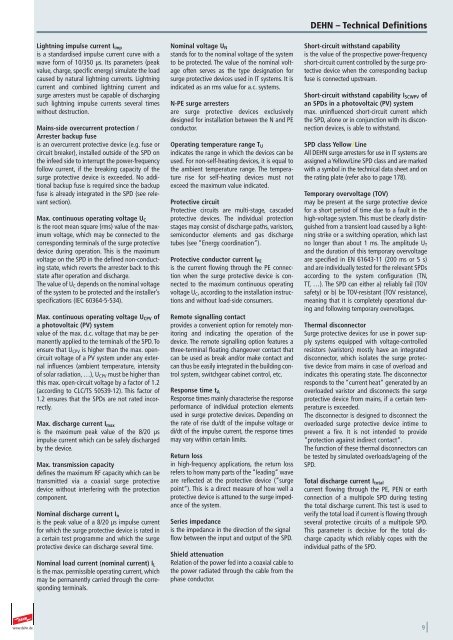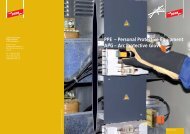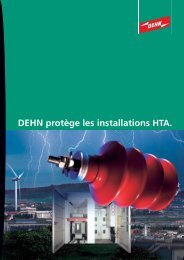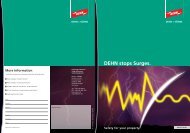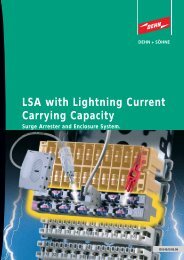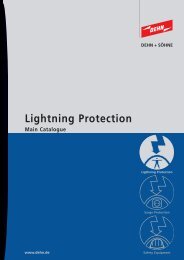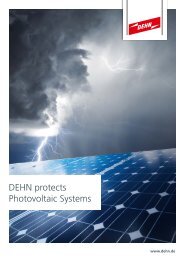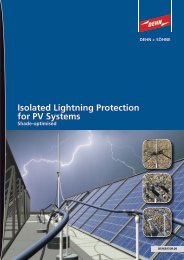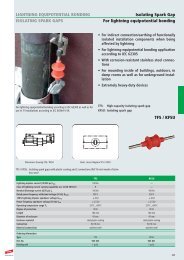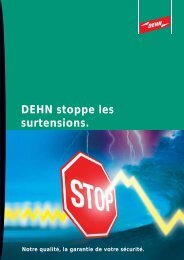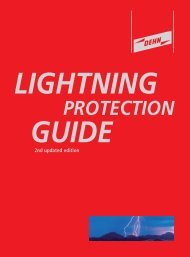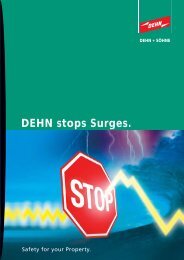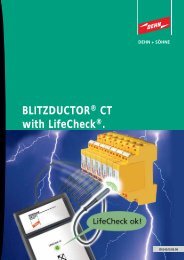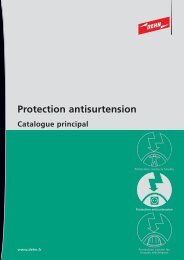Create successful ePaper yourself
Turn your PDF publications into a flip-book with our unique Google optimized e-Paper software.
DEHN – Technical Definitions<br />
Lightning impulse current I imp<br />
is a standardised impulse current curve with a<br />
wave form of 10/350 μs. Its parameters (peak<br />
value, charge, specific energy) simulate the load<br />
caused by natural lightning currents. Lightning<br />
current and combined lightning current and<br />
surge arresters must be capable of discharging<br />
such lightning impulse currents several times<br />
without destruction.<br />
Mains-side overcurrent protection /<br />
Arrester backup fuse<br />
is an overcurrent protective device (e.g. fuse or<br />
circuit breaker), installed outside of the SPD on<br />
the infeed side to interrupt the power-frequency<br />
follow current, if the breaking capacity of the<br />
surge protective device is exceeded. No additional<br />
backup fuse is required since the backup<br />
fuse is already integrated in the SPD (see relevant<br />
section).<br />
Max. continuous operating voltage U C<br />
is the root mean square (rms) value of the maximum<br />
voltage, which may be connected to the<br />
corresponding terminals of the surge protective<br />
device during operation. This is the maximum<br />
voltage on the SPD in the defined non-conducting<br />
state, which reverts the arrester back to this<br />
state after operation and discharge.<br />
The value of U C depends on the nominal voltage<br />
of the system to be protected and the installer’s<br />
specifications (IEC 60364-5-534).<br />
Max. continuous operating voltage U CPV of<br />
a photovoltaic (PV) system<br />
value of the max. d.c. voltage that may be permanently<br />
applied to the terminals of the SPD. To<br />
ensure that U CPV is higher than the max. opencircuit<br />
voltage of a PV system under any external<br />
influences (ambient temperature, intensity<br />
of solar radiation, …), U CPV must be higher than<br />
this max. open-circuit voltage by a factor of 1.2<br />
(according to CLC/TS 50539-12). This factor of<br />
1.2 ensures that the SPDs are not rated incorrectly.<br />
Max. discharge current I max<br />
is the maximum peak value of the 8/20 μs<br />
impulse current which can be safely discharged<br />
by the device.<br />
Max. transmission capacity<br />
defines the maximum RF capacity which can be<br />
transmitted via a coaxial surge protective<br />
device without interfering with the protection<br />
component.<br />
Nominal discharge current I n<br />
is the peak value of a 8/20 μs impulse current<br />
for which the surge protective device is rated in<br />
a certain test programme and which the surge<br />
protective device can discharge several time.<br />
Nominal load current (nominal current) I L<br />
is the max. permissible operating current, which<br />
may be permanently carried through the corresponding<br />
terminals.<br />
Nominal voltage U N<br />
stands for to the nominal voltage of the system<br />
to be protected. The value of the nominal voltage<br />
often serves as the type designation for<br />
surge protective devices used in IT systems. It is<br />
indicated as an rms value for a.c. systems.<br />
N-PE surge arresters<br />
are surge protective devices exclusively<br />
designed for installation between the N and PE<br />
conductor.<br />
Operating temperature range T U<br />
indicates the range in which the devices can be<br />
used. For non-self-heating devices, it is equal to<br />
the ambient temperature range. The temperature<br />
rise for self-heating devices must not<br />
exceed the maximum value indicated.<br />
Protective circuit<br />
Protective circuits are multi-stage, cascaded<br />
protective devices. The individual protection<br />
stages may consist of discharge paths, varistors,<br />
semiconductor elements and gas discharge<br />
tubes (see “Energy coordination“).<br />
Protective conductor current I PE<br />
is the current flowing through the PE connection<br />
when the surge protective device is connected<br />
to the maximum continuous operating<br />
voltage U C , according to the installation instructions<br />
and without load-side consumers.<br />
Remote signalling contact<br />
provides a convenient option for remotely monitoring<br />
and indicating the operation of the<br />
device. The remote signalling option features a<br />
three-terminal floating changeover contact that<br />
can be used as break and/or make contact and<br />
can thus be easily integrated in the building control<br />
system, switchgear cabinet control, etc.<br />
Response time t A<br />
Response times mainly characterise the response<br />
performance of individual protection elements<br />
used in surge protective devices. Depending on<br />
the rate of rise du/dt of the impulse voltage or<br />
di/dt of the impulse current, the response times<br />
may vary within certain limits.<br />
Return loss<br />
in high-frequency applications, the return loss<br />
refers to how many parts of the “leading“ wave<br />
are reflected at the protective device (“surge<br />
point“). This is a direct measure of how well a<br />
protective device is attuned to the surge impedance<br />
of the system.<br />
Series impedance<br />
is the impedance in the direction of the signal<br />
flow between the input and output of the SPD.<br />
Shield attenuation<br />
Relation of the power fed into a coaxial cable to<br />
the power radiated through the cable from the<br />
phase conductor.<br />
Short-circuit withstand capability<br />
is the value of the prospective power-frequency<br />
short-circuit current controlled by the surge protective<br />
device when the corresponding backup<br />
fuse is connected upstream.<br />
Short-circuit withstand capability I SCWPV of<br />
an SPDs in a photovoltaic (PV) system<br />
max. uninfluenced short-circuit current which<br />
the SPD, alone or in conjunction with its disconnection<br />
devices, is able to withstand.<br />
SPD class Yellow/Line<br />
All DEHN surge arresters for use in IT systems are<br />
assigned a Yellow/Line SPD class and are marked<br />
with a symbol in the technical data sheet and on<br />
the rating plate (refer also to page 178).<br />
Temporary overvoltage (TOV)<br />
may be present at the surge protective device<br />
for a short period of time due to a fault in the<br />
high-voltage system. This must be clearly distinguished<br />
from a transient load caused by a lightning<br />
strike or a switching operation, which last<br />
no longer than about 1 ms. The amplitude U T<br />
and the duration of this temporary overvoltage<br />
are specified in EN 61643-11 (200 ms or 5 s)<br />
and are individually tested for the relevant SPDs<br />
according to the system configuration (TN,<br />
TT, …). The SPD can either a) reliably fail (TOV<br />
safety) or b) be TOV-resistant (TOV resistance),<br />
meaning that it is completely operational during<br />
and following temporary overvoltages.<br />
Thermal disconnector<br />
Surge protective devices for use in power supply<br />
systems equipped with voltage-controlled<br />
resistors (varistors) mostly have an integrated<br />
disconnector, which isolates the surge protective<br />
device from mains in case of overload and<br />
indicates this operating state. The disconnector<br />
responds to the “current heat“ generated by an<br />
overloaded varistor and disconnects the surge<br />
protective device from mains, if a certain temperature<br />
is exceeded.<br />
The disconnector is designed to disconnect the<br />
overloaded surge protective device intime to<br />
prevent a fire. It is not intended to provide<br />
“protection against indirect contact“.<br />
The function of these thermal disconnectors can<br />
be tested by simulated overloads/ageing of the<br />
SPD.<br />
Total discharge current I total<br />
current flowing through the PE, PEN or earth<br />
connection of a multipole SPD during testing<br />
the total discharge current. This test is used to<br />
verify the total load if current is flowing through<br />
several protective circuits of a multipole SPD.<br />
This parameter is decisive for the total discharge<br />
capacity which reliably copes with the<br />
individual paths of the SPD.<br />
www.dehn.de<br />
9


